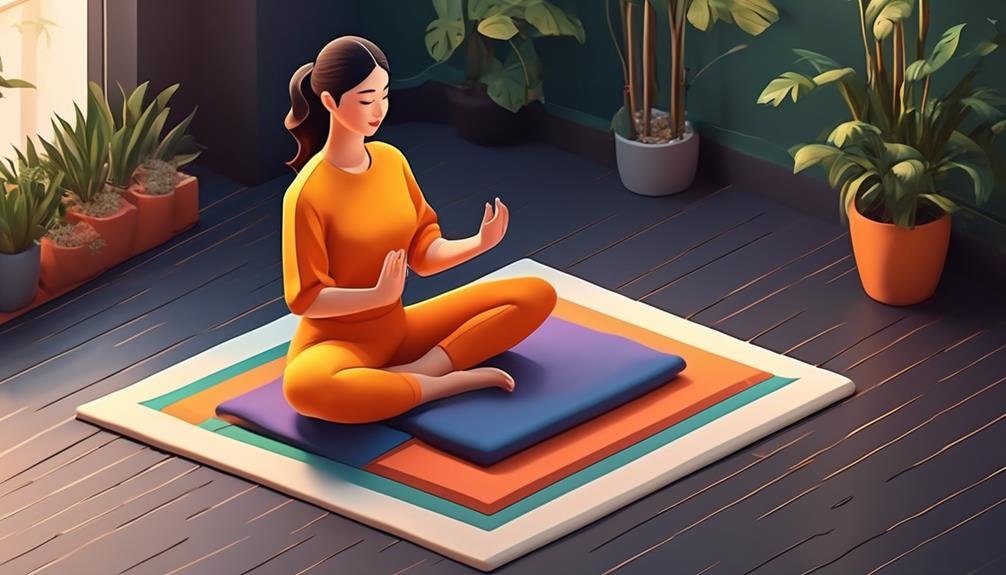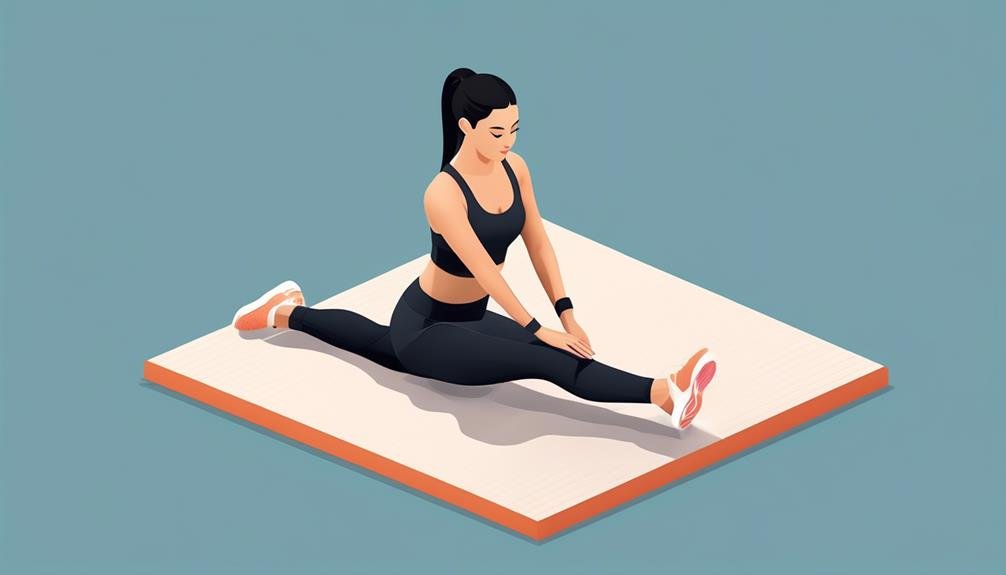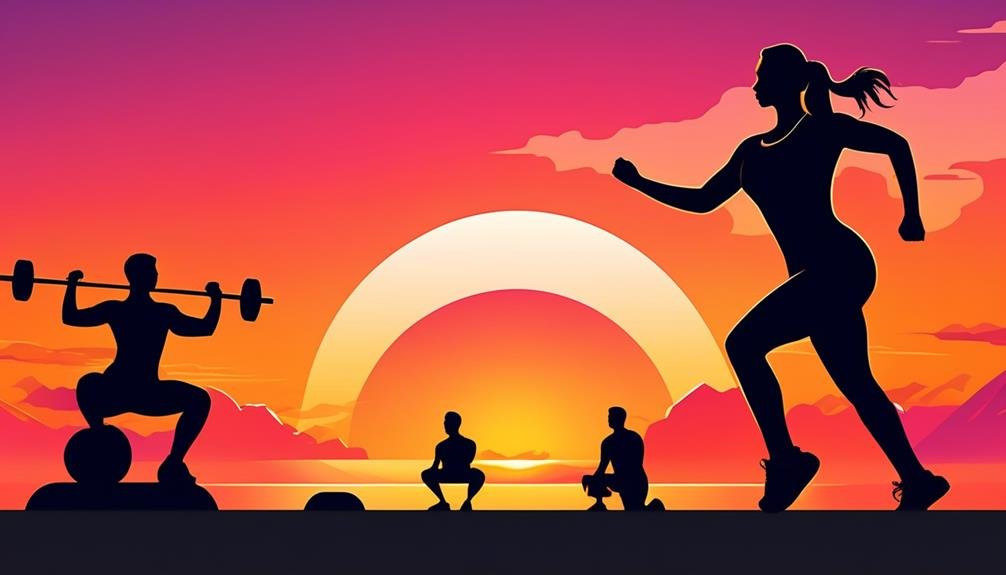You may be thinking, 'I've already completed a challenging weight lifting session, do I really need to do more exercises?' The answer is yes, and here's why.
Stretching and cool-down exercises are an essential part of your post-workout routine, helping your body gradually transition from intense activity to a resting state.
Not only do these exercises aid in muscle recovery and flexibility, but they also reduce muscle soreness, prevent dizziness, remove waste products from your muscles, and improve your overall range of motion.
So, if you want to maximize the benefits of your weight lifting session and ensure a healthy recovery, keep reading to discover the stretching and cool-down exercises that will leave you feeling refreshed and ready for your next workout.
Key Takeaways
- Neck and shoulder stretches, chest and upper back stretches, arm and wrist stretches, core and abdominal stretches, and hip and glute stretches are all important after weightlifting.
- Proper form is crucial when performing stretches to prevent injury.
- Stretching after weightlifting improves flexibility, prevents muscle soreness and tightness, and promotes optimal recovery.
- Incorporating stretches into your routine increases range of motion in lower legs and ankles and enhances hip and glute health.
Neck and Shoulder Stretches
To properly warm up and stretch your neck and shoulders before weight lifting, incorporate a series of exercises such as neck rolls, shoulder stretches, chin to chest stretches, ear to shoulder stretches, and armpit stretches. These stretches will help loosen the muscles in your neck and shoulders, reducing the risk of injury during weight lifting.
Start with neck rolls, gently rotating your head in a circular motion to stretch the muscles in your neck. Then, move on to shoulder stretches by extending one arm across your chest and using your other arm to gently pull it closer to your body. This stretch targets the muscles in your shoulders and upper back.
Next, perform chin to chest stretches by slowly lowering your chin towards your chest, feeling a stretch in the back of your neck. Follow this with ear to shoulder stretches, where you tilt your head to one side, bringing your ear closer to your shoulder. This stretch targets the muscles on the side of your neck.
Finally, finish with armpit stretches by raising your arm overhead and gently pulling it towards the opposite side of your body. This stretch helps release tension in the muscles around your armpit and upper back.
Incorporating these neck and shoulder stretches into your warm-up routine will help prepare your muscles for weight lifting, reducing the risk of strain or injury. Remember to also include a cool-down session after your weight lifting workout to help relax and stretch your muscles.
Chest and Upper Back Stretches
After warming up your neck and shoulders, it's important to also stretch your chest and upper back muscles to further prepare your body for weight lifting. Here are some effective chest and upper back stretches to incorporate into your cool-down routine:
- Doorway pec stretch: Stand in a doorway with both arms outstretched and positioned at a 90-degree angle against the doorframe. Lean forward slightly to feel a stretch in your pec muscles.
- Seated twist for upper back: Sit on the floor with your legs crossed. Place your left hand on your right knee and gently twist your upper body to the right. Hold for a few seconds and repeat on the other side.
- Thread the needle stretch: Begin on all fours and extend your right arm underneath your left arm, placing your right shoulder and cheek on the ground. Hold for a deep stretch, and then switch sides.
- Child's pose with arm reach: Start on your hands and knees, then sit back on your heels and extend your arms overhead, bringing your forehead to the ground. This stretch targets both the chest and upper back.
Remember to maintain proper form during these stretches. Keep your chest open and your elbows slightly bent to avoid straining the muscles. Arch your back to deepen the stretch.
Incorporating these chest and upper back stretches into your cool-down routine will help promote flexibility and prevent muscle tightness after weight lifting.
Arm and Wrist Stretches

Incorporating arm and wrist stretches into your cool-down routine is essential for maintaining flexibility and preventing muscle tightness after weight lifting. These exercises target the muscles in your arms and wrists, helping to alleviate any tension and improve your range of motion. Here are some arm and wrist stretches that you can include in your cool-down routine:
| Stretch | Instructions |
|---|---|
| Wrist flexor stretch | Extend your right arm in front of you, palm facing up. Use your left hand to gently bend your right hand back towards your body. Hold for 15-30 seconds, then repeat on the other side. |
| Wrist extensor stretch | Extend your right arm in front of you, palm facing down. Use your left hand to gently bend your right hand down towards the floor. Hold for 15-30 seconds, then repeat on the other side. |
| Arm across chest stretch | Reach your right arm across your chest and gently pull it towards your body with your left hand. Hold for 15-30 seconds, then switch sides. |
| Arm behind back stretch | Extend your right arm behind your back and reach towards your left side. Use your left hand to gently pull your right arm further. Hold for 15-30 seconds, then switch sides. |
| Forearm stretch | Extend your right arm in front of you, fingers pointing down. Use your left hand to gently bend your right hand down towards the floor. Hold for 15-30 seconds, then repeat on the other side. |
Remember to breathe deeply and relax into each stretch. If you feel any pain or discomfort, ease off the stretch. By incorporating these arm and wrist stretches into your cool-down routine, you can help prevent muscle tightness and maintain flexibility in your upper body.
Core and Abdominal Stretches
For optimal flexibility and muscle relief in your core and abdominal muscles, incorporate these effective stretches into your cool-down routine:
- Cat Cow stretch: This stretch targets the core and abdominal muscles by alternating between arching and rounding your back like a cat and cow. It helps increase flexibility and range of motion in the spine, improving posture and relieving tension in the lower back.
- Seated Twist: Sit on the floor with your legs extended in front of you, then cross one leg over the other and twist your torso in the opposite direction. This stretch targets the core and oblique muscles, promoting flexibility and releasing tension in the midsection.
- Lower Back Rotational Stretch: Lie on your back with your knees bent and feet flat on the floor. Gently rotate your knees from side to side, allowing your lower back to stretch and release tension. This exercise improves flexibility in the core and lower back.
- Behind-the-Back Forearm Grip Stretch: Stand with your feet shoulder-width apart and clasp your hands behind your lower back. Slowly lift your hands away from your body, feeling the stretch in your abdominal muscles. This stretch engages the core and helps improve flexibility in the abdominal area.
Incorporating these core and abdominal stretches into your cool-down routine will aid in relieving muscle tension and promoting flexibility in these important muscle groups. Remember to perform each stretch with proper form and hold for 15-30 seconds to achieve the best results.
Hip and Glute Stretches

To effectively stretch and relieve tension in your hips and glutes, incorporate these evidence-based exercises into your cool-down routine:
Exercise | Description
— | —
Standing Figure Four Stretch | Stand tall and cross your right ankle over your left knee. Bend your left knee and lower into a squat position. You should feel a stretch in your right hip and glute. Hold for 30 seconds, then switch sides.
Lizard Pose | Start in a high plank position. Step your right foot forward, placing it outside of your right hand. Lower your left knee to the ground and sink your hips down. Feel the stretch in your hip flexors, groin, and glutes. Hold for 30 seconds, then switch sides.
Seated Figure Four Stretch | Sit on the ground with your legs extended. Cross your right ankle over your left knee and flex your right foot. Gently press down on your right knee to deepen the stretch in your right hip and glute. Hold for 30 seconds, then switch sides.
Supine Piriformis Stretch | Lie on your back with both knees bent and feet flat on the ground. Cross your right ankle over your left thigh, just above the knee. Reach your left hand through and clasp your hands behind your left thigh. Pull your left knee towards your chest to stretch the glutes and piriformis muscle. Hold for 30 seconds, then switch sides.
Pigeon Pose | Start in a high plank position. Bring your right knee forward and place it behind your right wrist. Extend your left leg straight behind you. Sink your hips down and forward, feeling the stretch in your right hip and glute. Hold for 30 seconds, then switch sides.
Incorporating these hip and glute stretches into your cool-down routine can help improve flexibility, release tension, and prevent post-workout soreness. Remember to listen to your body and perform these stretches within a comfortable range of motion. By taking the time to properly cool down and stretch, you can enhance your recovery and maintain optimal hip and glute health.
Leg and Hamstring Stretches
Incorporate these evidence-based leg and hamstring stretches into your cool-down routine to improve flexibility, prevent muscle tightness, and promote optimal recovery.
- Standing single leg hamstring stretch:
Stand with your feet hip-width apart. Lift your right leg and place your left hand on your left hip for support. Extend your right leg forward, flexing your foot. Keep your back straight as you hinge forward from your hips. Feel the stretch in the back of your right leg. Hold for 20-30 seconds and then switch sides.
- Seated hamstring stretch:
Sit on the floor with your legs extended in front of you. Bend your left knee and place your left foot against your right inner thigh. Reach forward with your left hand and try to touch your right foot. Keep your back straight and avoid rounding your shoulders. Hold for 20-30 seconds and then switch sides.
- Lying hamstring stretch:
Lie on your back with your left leg extended on the floor. Bend your right knee and place your right foot on the floor. Lift your right arm and place your left hand on your right knee. Gently pull your right knee towards your chest, feeling the stretch in the back of your right leg. Hold for 20-30 seconds and then switch sides.
- Standing forward bend hamstring stretch:
Stand with your feet hip-width apart. Bend forward from your hips, reaching towards your toes. Keep your knees slightly bent if needed. Feel the stretch in the back of your legs. Hold for 20-30 seconds.
Calf and Ankle Stretches

After completing the leg and hamstring stretches, it's important to continue your cool-down routine by focusing on calf and ankle stretches. These stretches help improve flexibility and range of motion in the lower legs, preventing tightness and potential injury.
One effective stretch is the standing calf stretch. To do this, stand facing a wall with your left foot forward and your right foot back. Place your left hand on the wall at shoulder height and bend your left elbow. Keep your right hand on your right hip. Lean forward, keeping your right leg straight and your right heel on the ground. Hold the stretch for 15-30 seconds, then switch sides.
Another stretch is the seated calf stretch. Sit on the ground with your legs extended in front of you. Loop a towel or resistance band around the ball of your right foot. Hold the ends of the towel or band in your hands. Gently pull the towel or band towards you, feeling a stretch in your calf. Hold for 15-30 seconds, then switch sides.
Ankle circles are also beneficial for ankle mobility and flexibility. Sit on the ground with your legs extended. Lift your right leg off the ground and rotate your ankle in a circular motion, clockwise and counterclockwise. Repeat on the other side.
Lastly, incorporating exercises like downward dog and calf raises can help stretch and strengthen the calf muscles. Remember to perform these static stretches as part of your cool-down routine to relax and soothe your lower leg muscles.
Full Body Cool-Down Exercises
Start your full body cool-down by incorporating exercises such as Cat Cow, Seated Twist, Lower Back Rotational Stretch, Behind-the-Back Forearm Grip Stretch, and Up Dog. These exercises will help you relax your muscles and bring your heart rate back to normal after weight lifting.
- Cat Cow: Start on your hands and knees, then arch your back up like a cat and drop your belly towards the floor like a cow. Repeat this movement several times to stretch your spine.
- Seated Twist: Sit on the floor with your legs extended in front of you. Bend your right knee and place your right foot on the outside of your left knee. Twist your torso to the right, using your left arm to push against your right knee for a deeper stretch. Repeat on the other side.
- Lower Back Rotational Stretch: Lie on your back with your knees bent and feet flat on the floor. Keeping your shoulders on the ground, let both knees fall to the right side. Hold for a few seconds, then bring your knees back to the center and repeat on the left side.
- Behind-the-Back Forearm Grip Stretch: Stand up straight and extend your right arm in front of you. Bend your right elbow and reach your right hand over your right shoulder. Use your left hand to grasp your right hand from behind your back and gently pull to stretch your right forearm. Repeat on the other side.
Finish your cool-down with Up Dog. Start by lying face down on the floor with your hands on the ground next to your shoulders. Push up with your arms, lifting your chest and extending your spine. This stretch will help open up your chest and stretch your abdominal muscles.
Incorporating these exercises into your cool-down routine will help promote flexibility and prevent muscle soreness. Remember to listen to your body and adjust the intensity of the stretches as needed.
Frequently Asked Questions
What Is a Good Cool Down After Lifting Weights?
After lifting weights, a good cool down is important. Choose low-intensity activities like walking or yoga for about 5-10 minutes to gradually bring your heart rate and breathing back to normal.
How Should I Stretch After Lifting Weights?
After lifting weights, you should stretch to release tension and promote recovery. Stretch your neck and upper back with ear to shoulder and chin to chest stretches. Stretch your sides and shoulders with standing side reach and armpit stretches. Stretch your shoulders and triceps with specific exercises. Finally, stretch your hips and legs with standing lunges and hamstring stretches.
What Type of Stretching Would Be Appropriate for a Good Cool Down After Exercise?
To cool down after weightlifting, you should do easy exercise for 5 to 10 minutes, like light pedaling or easy laps. Then, do static stretches for your hamstrings, calves, and arms to relax and decrease motion.
How Do You Warm-Up and Cool Down Weightlifting?
To warm up for weightlifting, start with dynamic stretches like arm circles and leg swings. Then, perform a few light sets of each exercise. After lifting, cool down with stretches like the ear to shoulder stretch and child's pose.
Conclusion
In conclusion, incorporating a variety of stretching and cool-down exercises after weight lifting is crucial for muscle recovery and flexibility.
Neck and shoulder stretches, chest and upper back stretches, arm and wrist stretches, core and abdominal stretches, hip and glute stretches, leg and hamstring stretches, and calf and ankle stretches are all recommended.
Additionally, full body cool-down exercises like Child's Pose, Upward-facing Dog, and Lying Torso Twist can further aid in muscle recovery.
Cooling down after weight lifting helps reduce muscle soreness, prevent dizziness, remove waste products, and improve flexibility and range of motion.





